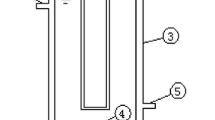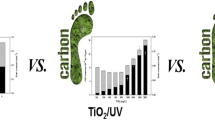Abstract
In the present study, a comparative assessment of 2,4,6-T (2,4,6-Trichlorophenol) degradation by different AOPs (Advanced Oxidation Processes – UV, UV/ H2O2, Fenton, UV/Fenton and UV/TiO2) in the laboratory scale is performed. The effects of different reactant concentrations and pH are assessed. 2,4,6-T removal, Total Organic Carbon mineralization (TOC) and dechlorination are monitored. Of all the AOPs, UV/Fenton process is more effective in degrading 2,4,6-T. The optimum conditions obtained for the best degradation with UV/Fenton are: pH = 3, Fe+2 concentration of about 5 ppm, and peroxide concentration of 100 ppm for an initial 100 ppm of 2,4,6 T concentration at room temperature. In these conditions, a pseudo first-order rate constant is evaluated. The degradation rate of 2,4,6 T followed the order:
















Similar content being viewed by others
References
Abe, K., & Tanaka, K. (1997). Fe3+ and UV-enhanced ozonation of chlorophenolic compounds in aqueous medium. Chemosphere, 35, 2837–2847. doi:10.1016/S0045–6535(97)00344–5.
Alaton, I. A., & Balcioglu, I. A. (2001). Photochemical and heterogeneous photocatalytic degradation of waste vinylsulphone dyes: a case study with hydrolysed reactive Black 5. Journal of Photochemistry and Photobiology A Chemistry, 141, 247–254. doi:10.1016/S1010–6030(01)00440–3.
Alaton, I. A., Balcioglu, I. A., & Bahnemann, D. W. (2002). Advanced oxidation of a reactive dye bath effluent: comparison of O3, H2O2/UV-C and TiO2/UV-A processes. Water Research, 36, 1143–1154. doi:10.1016/S0043–1354(01)00335–9.
Aleboyeh, A., Moussa, Y., & Aleboyeh, H. (2005). Kinetics of oxidative decolourisation of Acid Orange 7 in water by ultraviolet radiation in the presence of hydrogen peroxide. Sep. Pur. Technol., 43, 143–148. doi:10.1016/j.seppur.2004.10.014.
Al Momani, F., Sans, C., & Esplugas, S. (2004). A comparative study of the advanced oxidation of 2,4-dichlorophenol. Journal of Hazardous Materials B, 107, 123–129. doi:10.1016/j.jhazmat.2003.11.015.
Alnaizy, R., & Akgerman, A. (2000). Advanced oxidation of phenolic compounds. Advances in Environmental Research, 4, 233–244. doi:10.1016/S1093–0191(00)00024–1.
Andreozzi, R., Caprio, V., Insola, A., & Marotta, R. (1999). Advanced oxidation processes (AOP) for water purification and recovery. Catalysis Today, 53, 51–59. doi:10.1016/S0920–5861(99)00102–9.
Annachhatre, A. P., & Gheewala, S. H. (1996). Biodegradation of chlorinated phenolic compounds. Biotechnology Advances, 14, 35–56. doi:10.1016/0734–9750(96)00002-X.
Auguliaro, V., Palmisano, L., & Schiavello, M. (1991). Photon absorption by aqueous TiO2 dispersion container in a stirred photo reactor. AIChE, 37, 1096–1100. doi:10.1002/aic.690370714.
Bali, U., Catalkaya, E., & Sengul, F. (2003). Photochemical degradation and mineralization of phenol: a Comparative study. J. Environmental Science and Health-Part A, 38, 2259–2275. doi:10.1081/ESE-120023373.
Bali, U., Catalkaya, E., & Sengul, F. (2004). Photodegradation of Reactive Black 5, Direct Red 28 and Direct Yellow 12 using UV, UV/H2O2 and UV/H2O2/Fe2+: A comparative study. J. Hazard. Mater. B, 114, 159–166. doi:10.1016/j.jhazmat.2004.08.013.
Beltran, F. J., Ovejero, G., & Rivers, J. (1996). Oxidation of polynuclear aromatic hydrocarbon in water.3. UV radiation combined with hydrogen peroxide. Industrial & Engineering Chemistry Research, 35, 883–889. doi:10.1021/ie950363l.
Benitez, J. F., Heredia, J. B., Acero, J. L., & Rubio, F. J. (1999). Chemical decomposition of 2,4,6-trichlorophenol by ozone, Fenton’s reagent, and UV radiation. Industrial & Engineering Chemistry Research, 38, 1341–1349. doi:10.1021/ie980441f.
Benitez, J. F., Heredia, J. B., Acero, J. L., & Rubio, F. J. (2000). Contribution of free radicals to chlorophenols decomposition by several advanced oxidation processes. Chemosphere, 41, 1271–1277. doi:10.1016/S0045–6535(99)00536–6.
Czaplicka, M. (2006). Photo-degradation of chlorophenols in the aqueous solution. Journal of Hazardous Materials, 134, 45–59. doi:10.1016/j.jhazmat.2005.10.039.
De, A. K., Chaudhuri, B., Bhattacharjee, S., & Dutta, B. K. (1999). Estimation of OH radical reaction rate constants for phenol and chlorinated phenols using UV/H2O2 photo-oxidation. Journal of Hazardous Materials, 64, 91–104. doi:10.1016/S0304–3894(98)00225–8.
Federico, M., Fernando, V., & Natalia, V. (2006). Changes in solution color during phenol oxidation by Fenton reagent. Environ. Sci. and Technol. A, 40, 5538–5543. doi:10.1021/es060866q.
Galindo, C., Jacques, P., & Kalt, A. (2001). Photochemical and photocatalytic degradation of an indigoid dye: A case study of acid blue 74 (AB74). Journal of Photochemistry and Photobiology A Chemistry, 141, 47–56. doi:10.1016/S1010–6030(01)00435-X.
Ghaly, M. Y., Hartel, G., Mayer, R., & Haseneder, R. (2001). Photochemical oxidation of p-chlorophenol by UV/H2O2 and photofenton process-A comparative study. Water Management, 21, 41–47.
Graham, N., Chu, W., & Lau, C. (2003). Observation of 2,4,6-trichlorophenol degradation by ozone. Chemosphere, 51, 237–243. doi:10.1016/S0045–6535(02)00815–9.
Hugul, M., Apak, R., & Demirci, S. (2000). Modeling the kinetics of UV hydrogen peroxide oxidation of some mono-, di-, and trichlorophenols. Journal of Hazardous Materials B, 77, 193–208. doi:10.1016/S0304–3894(00)00246–6.
Hugul, M., Ercag, E., & Apak, R. (2002). Kinetic studies on UV-Photodegradation of some chlorophenols using TiO2 catalyst. Journal of Environmental Science and Health. Part A, Environmental Science and Engineering & Toxic and Hazardous Substance Control, 37, 365–383.
Kang, N., Soo Lee, D., & Yoon, J. (2002). Kinetic modeling of Fenton oxidation of phenol and monochlorophenols. Chemosphere, 47, 915–924. doi:10.1016/S0045–6535(02)00067-X.
Kavitha, V., & Palanivelu, K. (2003). Degradation of 2-Chlorophenol by Fenton and Photo-Fenton Processes—A Comparative Study. Journal of Environmental Science and Health. Part A, Toxic/Hazardous Substances & Environmental Engineering, 38, 1215–1231. doi:10.1081/ESE-120021121.
Kavitha, V., & Palanivelu, K. (2004). The role of ferrous ion in Fenton and photo-Fenton processes for the degradation of phenol. Chemosphere, 55, 1235–1243. doi:10.1016/j.chemosphere.2003.12.022.
Kavitha, V., & Palanivelu, K. (2005). Degradation of nitrophenols by Fenton and photo-Fenton processes. Journal of Photochemistry and Photobiology A Chemistry, 170, 83–95. doi:10.1016/j.jphotochem.2004.08.003.
Legrini, O., Oliveros, E., & Braun, A. M. (1993). Photochemical processes for water treatment. Chemical Reviews, 93, 671–698. doi:10.1021/cr00018a003.
Mandal, A., Ojha, K., Asim De, K., & Bhattacharjee, S. (2004). Chemical Engineering Journal, 102, 203–208.
Marshall, W. D., Kubatova, A., Lagadec, A. J. M., Miller, D. M., & Hawthorne, S. B. (2002). Zero-valent metal accelerator for the dechlorination of pentachlorophenol (PCP) in subcritical water. Green Chemistry, 4, 17–23. doi:10.1039/b108337f.
Meric, S., Kaptan, D., & Olmez, T. (2004). Colour and COD removal from wastewater containing Reactive Black 5 using Fenton’s oxidation process. Chemosphere, 54, 435–441. doi:10.1016/j.chemosphere.2003.08.010.
Neppolian, B., Kanel, S. R., Choi, H. C., Shankar, M. V., Arbindoo, B., & Murugesan, V. (2003). Photo catalytic degradation of reactive yellow 17 dye in aqueous solution in the presence of TiO2 with cement binder. International journal of Photoenergy, 5, 45–49.
Pera-Titus, M., Garcia-Molina, V., Banos, M. A., Gimenez, J., & Esplugas, S. (2004). Degradation of chlorophenols by means of advanced oxidation processes: a general review. Applied Catalysis B Environmental, 47, 219–256. doi:10.1016/j.apcatb.2003.09.010.
Priya, M. H., & Madras, G. (2005). Kinetics of photocatalytic degradation of phenols with multiple substituent groups. Journal of Photochemistry and Photobiology A Chemistry, 179, 256–262. doi:10.1016/j.jphotochem.2005.08.022.
Rao, N. N., Dubey, A. K., Mohanty, S., Khare, P., Jain, R., & Kaul, S. N. (2003). Photo catalytic degradation of 2-chlorophenol: a study of kinetics, intermediates and biodegradability. Journal of Hazardous Materials B, 101, 301–314. doi:10.1016/S0304–3894(03)00180–8.
Rideh, L., Wehrer, A., Ronze, D., & Zoulalian, A. (1997). Photocatalytic degradation of 2-chlorophenol in TiO2 aqueous suspension: modeling of reaction rate. Industrial & Engineering Chemistry Research, 36, 4712–4718. doi:10.1021/ie970100m.
Schrank, S. G., Jose, H. J., Moreira, R. F. P. M., & Schroder, H. Fr. (2005). Applicability of Fenton and H2O2/UV reactions in the treatment of tannery wastewaters. Chemosphere, 60, 644–655. doi:10.1016/j.chemosphere.2005.01.033.
Serpone, N., Texier, I., Emeline, A. V., Pichat, P., Hidaka, H., & Zhaoe, J. (2000). Post-irradiation effect and reductive dechlorination of chlorophenols at oxygen-free TiO2/water interfaces in the presence of prominent hole scavengers. Journal of Photochemistry and Photobiology A Chemistry, 136, 145–155. doi:10.1016/S1010–6030(00)00348–8.
Skurlatov, Y. I., Ernestova, L. S., Vichutinskaya, E. V., Samsonov, D. P., Pervunina, R. I., Semenova, I. V., & Shvydky, V. O. (1998). Acta Hydrochimica et Hydrobiologica, 26, 31–35. doi:10.1002/(SICI)1521–401X(199801)26:1<31::AID-AHEH31>3.0.CO;2–2
Song-hu, Y., & Xiao-hua, L. (2005). Comparison treatment of various chlorophenols by electro-Fenton method: relationship between chlorine content and degradation. Journal of Hazardous Materials, B118, 85–92. doi:10.1016/j.jhazmat.2004.08.025.
Stefan, M. I., Hoy, A. R., & Bolton, J. R. (1996). Kinetics and mechanism of the degradation and mineralization of acetone in dilute aqueous solution sensitized by the UV photolysis of hydrogen peroxide. Environmental Science & Technology, 30, 2382–2390. doi:10.1021/es950866i.
Trapido, M., & Kallas, J. (2000). Advanced oxidation processes for the degradation and detoxification of 4- nitrophenol. Environmental Technology, 21, 799–808.
Walter, Z. T., & Huang, C. P. (1995). The effect of chlorine position of chlorinated phenols on their dechlorination kinetics by Fenton's reagent. Waste Management (New York, N.Y.), 15, 615–622. doi:10.1016/0956–053X(96)00022–0.
Yamila, A., Liendo, F., & Nunez, O. (2003). On the Fenton degradation mechan ism-The role of oxalic acid. ARKIVOC, x, 538–549.
Zappi, M., Teeter, C., Fleming, E., & Francingues, N. (1991). Treatability of Nine Avenue Superfund Site Groundwater, Report # MP-EL-91–8, US Army Engineers Waterways Experiment Station.
Author information
Authors and Affiliations
Corresponding author
Rights and permissions
About this article
Cite this article
Saritha, P., Raj, D.S.S., Aparna, C. et al. Degradative Oxidation of 2,4,6 Trichlorophenol Using Advanced Oxidation Processes – A Comparative Study. Water Air Soil Pollut 200, 169–179 (2009). https://doi.org/10.1007/s11270-008-9901-y
Received:
Accepted:
Published:
Issue Date:
DOI: https://doi.org/10.1007/s11270-008-9901-y




